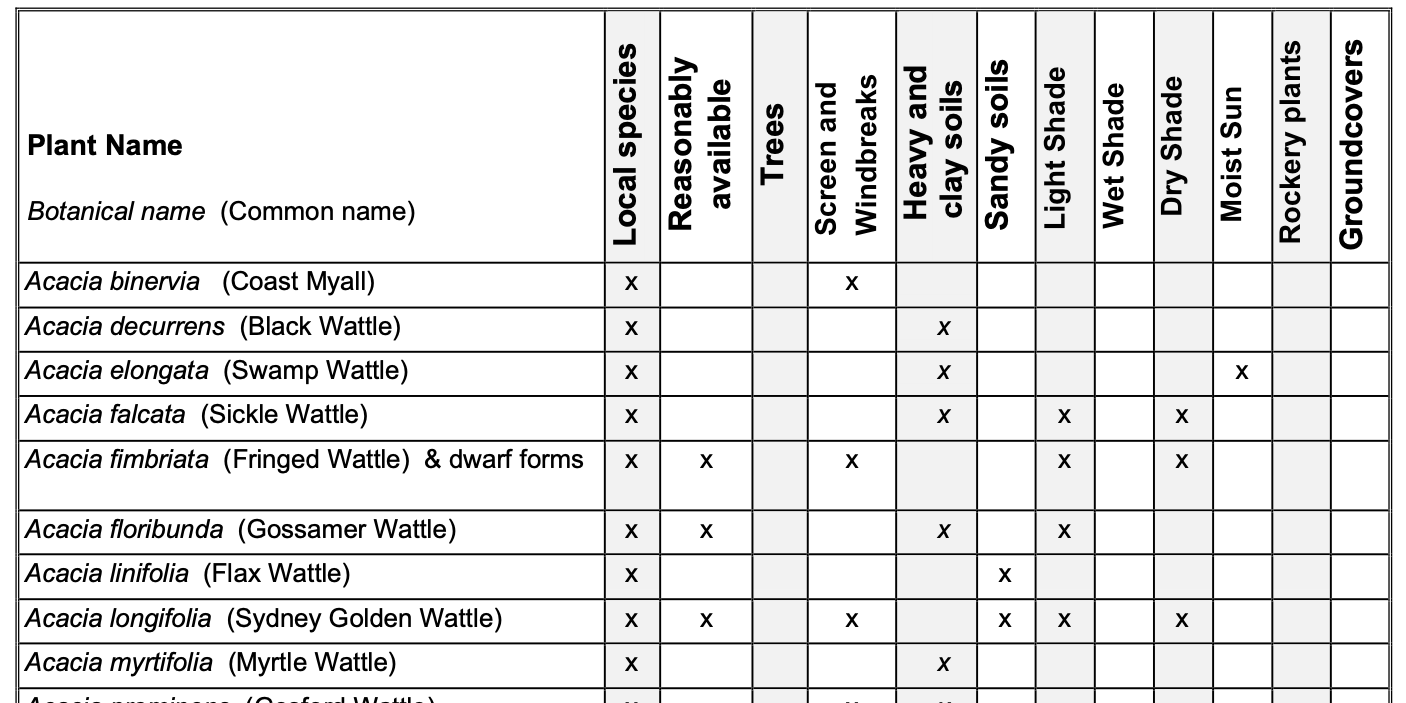Hunter Valley District Group |
Resources |
Here is lots of information about native plants - where to buy them, which ones are indigenous to the Hunter region and journals of interest. See the Activities page for great native gardens in the Hunter. |
Where to buy native plants |
APS Newcastle GroupOpen Thursday mornings at the Hunter Wetlands Centre. Very wide range of native and indigenous tubestock. Riverdene Nurseryhttp://www.riverdenenursery.com.au/, 80 Allyn River Rd, East Gresford. OPEN Mon & Tues - 9am to 12pm plus Fridays - 9am-3pm. CLOSED Wed & Thursday's, Public Holidays and Weekends Newcastle Wildflower Nurseryhttp://www.newcastlewildflower.com.au/, Open 7 days, 260 Lake Rd, Glendale. Offer 10% off for APS members. Trees in Newcastlehttp://www.treesinnewcastle.org.au/, Open Friday mornings, 9am - 1pm, Belmont Wetlands State Park, 119 Kalaroo Road, Redhead NSW 2290 | The Hunter Region Botanic Gardenshttps://www.huntergardens.org.au/, Stocks a range of native plants. Hunter Indigenous Plantshttp://www.hunterindigenousplants.com.au/ 36 Weakley's Dr., Beresfield. (by appointment). BunningsLocal Bunnings stores hold a wide range of native plants generally in larger pots. |
How to design a native garden |
The Australian Garden Design Study Group operates as one of the many Study Groups under the umbrella of the Australian Native Plants Society (Australia). It provides a raft of information to help you design and build your native garden. Click for a link to this story on the garden design process. |
Are you keen to create a garden that attracts native wildlife and helps rebuild the environment? A bushland or habitat garden mimics nature. Such gardens are designed to create as much habitat as possible for local wildlife. This means they have to be multilayered, diverse and complex and create food and shelter year round. Click here for a story on how to create a bushland or habitat garden. |
|
What grows well |
Below are plants which grow well in the Hunter Valley. The ones marked * are indigenous i.e. they only grow in the Hunter Region. Also checkout our very large searchable database of plants, grouped by sizes here: https://resources.austplants.com.au/plant-database/ |
Acacia elongata, Swamp Wattle Acacia falcata - Sickle Leaf Wattle Banksia spinulosa var. spinulosa - Hairpin Banksia Acacia pendula - Weeping Myall Banksia oblongifolia - Rusty Banksia Brachyscome multifida - Cut-leaved Daisy Chrysocephalum apiculatum - Yellow Buttons Dendrobium speciosum - Rock Orchid Elaeocarpus reticulatus - Blueberry Ash * Eucalyptus fracta - Broken Back Ironbark * Eucalyptus pumila - Pokolbin Mallee Goodenia hederacea - Ivy Goodenia Grevillea guthrieana - Guthrie’s Grevillea Grevillea johnsonii - Johnson's Grevillea * Grevillea montana - Hunter Valley Grevillea * Grevillea parviflora subsp. parviflora - Small-flower Grevillea * Grevillea virgata, Nerong Grevillea Hardenbergia violacea - Purple Coral Pea, False Sarsaparilla | Hibbertia dentata -Trailing guinea flower Hibiscus heterophyllus - Native Rosella Hymenosporum flavum - Native Frangipani Indigofera australis - Australian Indigo Kennedia rubicunda - Running Postman Melaleuca thymifolia - Thyme honey-myrtle Melia azedarach - White Cedar Pandorea pandorana - Wonga Wonga Vine * Persoonia pauciflora - North Rothbury Persoonia Pittosporum multiflorum - Orange Thorn * Prostanthera cineolifera - Singleton Mint-bush Pterostylis curta - Blunt Greenhood Pterostylis nutans - Nodding Greenhood Senna artemisioides subsp. filifolia - Desert Cassia |
Here is another excellent selection of plants which grow well in the Newcastle and Lower Hunter regions, compiled by APS Newcastle Group. Plant Guide Newcastle (v2).pdf. Here is a sample. |
|
Plant profiles of many of the plants listed above have been developed by Mark Abell. Ones marked with * only grow in the Hunter (I.e. are indigenous). Click here to see the profiles.
Journals and newsletters |
Journals, books & newsletters of InterestVegetation guide to the Hunter Valley Excellent resource which draws on Professor David Keith's work into the ecosystems and plants in NSW including the Hunter Valley Flora of the Hunter Region, Stephen Bell, PDF  Book: Flora of the Hunter Region, Stephen Bell, Christine Rockley & Anne LLewellyn, CSIRO Clayton Vic, 2019 Book: Native Terrestrial Orchids of the Hunter Region Botanic Gardens Linda E McPherson, 2019. Self-published. Cunninghamia - Journal of plant ecology, especially Eastern AustraliaTelopea - Open access journal of plant Systemics.Australia Flora Foundation - Newsletter |

,%20farm%20garden,%20image%20Heather%20Miles%20_A023540.jpg)

